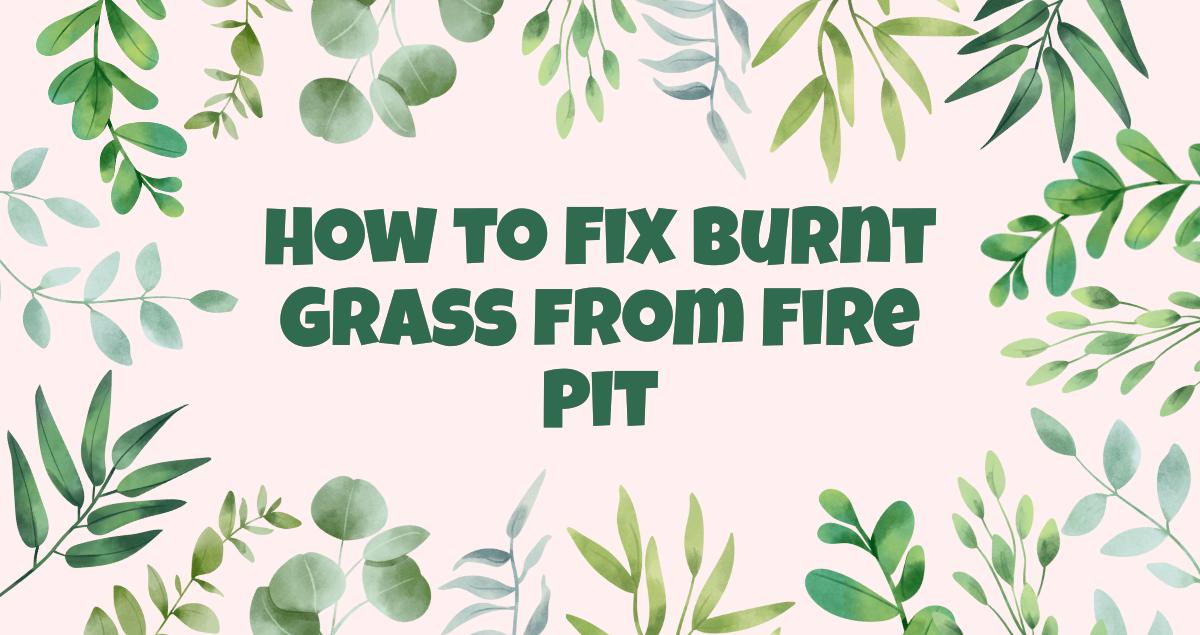Have you recently noticed burnt grass around your fire pit? It's a common problem that many homeowners face. While fire pits can be a great addition to your outdoor space, they can also cause damage to your lawn if not used properly. In this article, we'll discuss how to fix burnt grass from fire pit and prevent future damage.
Table of Content
How to Fix Burnt Grass from Fire Pit
To fix burnt grass from a fire pit, remove the charred grass and loosen the soil. Add topsoil and grass seed to the area, then water regularly. Cover the area with straw or mulch to retain moisture and protect the new grass.
Understanding the Damage
Assessing the Burnt Area
The first step in fixing burnt grass from a fire pit is to assess the damage. Walk around the area and identify the extent of the damage. If the burnt area is small, you may be able to fix it with some simple techniques. However, if the damage is extensive, you may need to take more drastic measures.
Causes of Burnt Grass
Before we discuss how to fix burnt grass, it's important to understand why it happens in the first place. Burnt grass from a fire pit can be caused by several factors, including:
- Excessive heat
- Embers or sparks from the fire
- Chemicals from fire starters
It's important to take preventive measures to avoid these causes and protect your lawn from damage.
How to Fix Burnt Grass from Fire Pit
Watering the Burnt Area
One of the easiest ways to revive burnt grass is by watering the area properly. Watering the area will help to cool the soil and promote new growth. However, it's important to water the area properly to avoid overwatering or underwatering. Make sure to water the area deeply and regularly until the grass starts to grow back.
Reseeding the Area
If the damage is extensive, you may need to reseed the area. Choose the right grass seeds that are suitable for your climate and soil type. Make sure to prepare the soil properly before planting the seeds. Follow the planting instructions carefully and keep the area moist until the new grass starts to grow.
Using Fertilizers and Soil Amendments
Using fertilizers and soil amendments can also help to promote grass growth and revive burnt grass. Choose the right type of fertilizer and soil amendment that is suitable for your lawn. Apply them according to the instructions and make sure to water the area properly after application.
Preventing Future Damage
Choosing the Right Fire Pit Location
Choosing the right location for your fire pit is crucial to prevent future damage to your lawn. Make sure to select a location that is far away from any trees, shrubs, or other flammable materials. Also, avoid placing the fire pit on grass or other vegetation.
Using Fire Pit Accessories
Using fire pit accessories such as a spark screen or fire pit mat can also help to prevent grass damage. A spark screen will prevent embers or sparks from flying out of the fire pit, while a fire pit mat will protect the grass underneath from excessive heat.
Conclusion
In conclusion, fixing burnt grass from a fire pit requires proper assessment and techniques such as watering, reseeding, and using fertilizers and soil amendments. However, it's important to take preventive measures to avoid future damage by choosing the right fire pit location and using fire pit accessories. By following these tips, you can enjoy your fire pit without damaging your lawn.
Frequently Asked Questions
How do you fix fire burned grass?
To fix fire burned grass, start by removing any charred or dead grass. Rake the area to loosen the soil and remove debris. Then, sprinkle grass seed evenly over the affected area and lightly rake it into the soil. Water the area regularly to keep the soil moist until the new grass starts to grow.
Will burnt grass from fire grow back?
Yes, burnt grass from a fire pit can grow back. With proper care and treatment, the grass will have the potential to regrow. Following the necessary steps such as removing the charred grass, reseeding, and providing adequate water and nutrients will help in the regrowth process.
Can burnt grass be fixed?
Yes, burnt grass can be fixed. By removing the damaged grass, reseeding the area, and providing proper care, the burnt patches can be restored. It may take some time for the new grass to grow and fill in the affected areas, but with patience and consistent maintenance, the burnt grass can be repaired.
How do you save grass from a fire pit?
To protect grass from a fire pit, create a safe zone around it. Clear any dry leaves, twigs, or other flammable materials from the area. Place a non-flammable barrier like rocks or bricks around the fire pit to prevent the fire from spreading. Avoid using the fire pit on windy days and always fully extinguish the fire before leaving the area. Regularly inspect the surrounding grass for any signs of damage or burning and take necessary steps to repair it if needed.
How long does it take for burnt grass to grow back?
The time it takes for burnt grass to grow back can vary depending on various factors such as the grass type, weather conditions, and proper care. Generally, it can take several weeks to a couple of months for the new grass to fully grow and fill in the burnt areas. Providing adequate water, sunlight, and nutrients will help expedite the regrowth process.
What type of grass is best for repairing burnt areas?
When repairing burnt areas, it is best to choose grass types that are known for their ability to recover and establish quickly. Some suitable options include perennial ryegrass, Kentucky bluegrass, and fine fescue. These grass varieties have good regrowth capabilities and can help restore the burnt areas effectively.
Can I use fertilizer to help fix burnt grass?
Yes, using fertilizer can aid in fixing burnt grass. Choose a balanced fertilizer with a nitrogen-rich formula, as nitrogen promotes healthy grass growth. Apply the fertilizer according to the manufacturer's instructions, taking care not to over-fertilize, as it can damage the grass further. Fertilizing the burnt areas will provide essential nutrients to the new grass and support its recovery.

